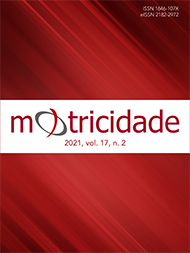The use of infrared thermography in endurance athletes: a systematic review
DOI:
https://doi.org/10.6063/motricidade.21116Keywords:
endurance training, thermography, cycling, runningAbstract
Infrared thermography has become increasingly common in sports assessment and has grown a lot over the past few years. Our objective was to identify the assessment protocols and the skin temperature behavior of practitioners of endurance sports. A systematic review was carried out following the PRISMA recommendations between the 1st and the 31st of March 2020, at MEDLINE, LILACS, SCOPUS, SPORT Discus, CINAHL, Web of Science, Science Direct, Cochrane, and Scielo, using combinations with 11 descriptors for “thermography” and 6 descriptors for “endurance training”. It was identified 24 different regions of interest evaluated region in endurance sports. The acclimatization time was respected in 75% of the selected studies, and the thermal images were acquired predominantly in three moments: before the test, immediately after the test, and 10 minutes after the test. It was observed that Tskin decreased in the initial moments and increased after exercise. It can be concluded that the regions of interest used were mostly the specific muscle recruited in each modality, with emphasis on the muscle groups of the lower limbs, and after this initial decrease in temperature, the thermal response is mainly dependent on the duration and intensity of exercise.
KEYWORDS: endurance training; thermography; cycling; running
Downloads
Published
Issue
Section
License
The authors of submitted manuscripts must transfer the full copyright to Journal Motricidade / Sílabas Didáticas Editions. Granting copyright permission allows the publication and dissemination of the article in printed or electronic formats, and copyrights start at the moment the manuscript is accepted for publication. It also allows Journal Motricidade to use and commercialise the article in terms of licensing, lending or selling its content to indexation/abstracts databases and other entities.
According to the terms of the Creative Commons licence, authors may reproduce a reasonable number of copies for personal or professional purposes, but without any economic gain. SHERPA/RoMEO allows authors to post a final digital copy (post-printing version) of the article on their websites or on their institutions' scientific repository.


